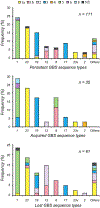Genotypic diversity and serotype distribution of group B streptococcus isolated from women before and after delivery
- PMID: 18462173
- PMCID: PMC9491394
- DOI: 10.1086/588296
Genotypic diversity and serotype distribution of group B streptococcus isolated from women before and after delivery
Abstract
Background: Most studies of the dynamics of maternal group B Streptococcus (GBS) colonization have relied on capsular serotyping to define GBS acquisition or loss. Newer molecular methods that distinguish GBS clones may expand our knowledge and influence vaccination strategies. We used multilocus sequence typing (MLST) and GBS capsular gene cluster (cps) genotyping to investigate the dynamics of perinatal GBS colonization.
Methods: A total of 338 GBS isolates obtained from 212 colonized women who were enrolled in a prior prospective cohort study were serotyped and genotyped by MLST and cps typing before (visit 1) and 6 weeks after (visit 2) delivery.
Results: Of the 212 women, 126 were colonized at both visits, whereas 66 lost and 20 acquired GBS by visit 2. MLST of the 338 strains identified 29 sequence types marking distinct bacterial clones. A change in sequence type or cps and serotype occurred in 23 (18.3%) of the 126 women who were colonized at both visits. Specific sequence types were associated with GBS loss and persistence. Older maternal age and exclusive intrapartum antibiotic use were associated with persistent colonization.
Conclusions: Although most GBS-positive pregnant women were stably colonized during the peripartum period, we detected changes in capsule expression and recolonization with antigenically distinct GBS clones over time by applying MLST. Combining the epidemiologic and molecular typing data revealed host factors and clones associated with persistent colonization, as well as a clone that was more readily lost. This knowledge is useful for the development of prevention and intervention strategies to reduce the likelihood of maternal GBS colonization.
Conflict of interest statement
Figures



References
-
- Schuchat A, Wenger JD. Epidemiology of group B streptococcal disease: risk factors, prevention strategies, and vaccine development. Epidemiol Rev 1994; 16:374–402. - PubMed
-
- Anthony BF, Eisenstadt R, Carter J, Kim KS, Hobel CJ. Genital and intestinal carriage of group B streptococci during pregnancy. J Infect Dis 1981; 143:761–6. - PubMed
-
- Baker CJ, Barrett FF. Transmission of group B streptococci among parturient women and their neonates. J Pediatr 1973; 83:919–25. - PubMed
-
- Davies HD, Adair C, McGeer A, et al. Antibodies to capsular polysaccharides of group B Streptococcus in pregnant Canadian women: relationship to colonization status and infection in the neonate. J Infect Dis 2001; 184:285–91. - PubMed
-
- Dillon HJ, Gray E, Pass M, Gray B. Anorectal and vaginal carriage of group B streptococci during pregnancy. J Infect Dis 1982; 145:794–9. - PubMed
Publication types
MeSH terms
Substances
Grants and funding
LinkOut - more resources
Full Text Sources
Other Literature Sources

